

3D Printing. SolarSinter : markus kayser. The maker movement isn’t just for hackers anymore. “I’ve always done a certain amount of work with my hands, but my whole career was in software.”
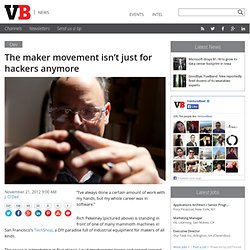
Rich Pekelney (pictured above) is standing in front of one of many mammoth machines in San Francisco’s TechShop, a DIY paradise full of industrial equipment for makers of all kinds. The space is intimidating at first glance. Loud mechanisms tower and sprawl around the workshop’s several stories; people in welding masks and heavy protective gloves quietly bustle from one corner to another. But after a few minutes in the shop, its aura of mystery quickly disappears. After all, people come here to learn, to weld, to screen print, to indulge their hobbies and acquire new skills. At TechShop’s San Francisco location, a $125 monthly membership fee gets you access to more than $1 million dollars of industrial-grade machinery, industry-standard design software for 2D and 3D projects, unlimited workshop hours, and coaching from experts in given techniques and materials. Engineering 3D-printed stem cells. Inside the stem cell printer.
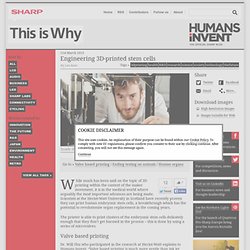
While much has been said on the topic of 3D printing within the context of the maker movement, it is in the medical world where arguably the most important advances are being made. Scientists at the Heriot-Watt University in Scotland have recently proven they can print human embryonic stem cells, a breakthrough which has the potential to revolutionise organ replacement in the coming years. The printer is able to print clusters of the embryonic stem cells delicately enough that they don’t get harmed in the process – this is done by using a series of microvalves. Valve based printing Dr. The cells maintained their important biological function of pluripotency. Print Your Own 3D models. PlusBooksanalysisinsightsopinionblog About BaekdalFollow Baekdal.

Researchers develop 3D-printed flying drones capable of self-assembly. News: a research team in Zürich has created a flock of helicopter robots that can detect each others' positions and join together to create a larger flying machine.
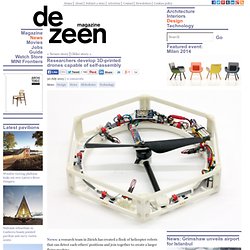
The Distributed Flight Array (DFA) has been developed by a team of researchers at the Institute for Dynamic Systems and Control (IDSC) at ETH Zürich university in Switzerland. 3D Models, Textures and Plugins at TurboSquid. Building a Bionic Ear. Lab-made organs could do more than just serve as ready options for patients in need: with the right blend of biology and materials science, they might even be able to endow people with superhuman abilities.
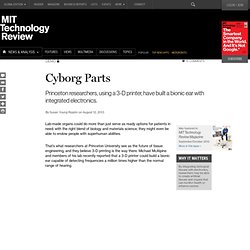
That’s what researchers at Princeton University see as the future of tissue engineering, and they believe 3-D printing is the way there. Michael McAlpine and members of his lab recently reported that a 3-D printer could build a bionic ear capable of detecting frequencies a million times higher than the normal range of hearing. The ear demonstrates how 3-D printing can seamlessly bring together electronics and biological tissues. Normally, these materials don’t play well together—one is rigid and fractures easily, while the other is soft and flexible. But with 3-D printing, the two can be fabricated together, says McAlpine. The team started with an ear because the shape is difficult to re-create with traditional tissue engineering. 3D Printing in Libraries Around the World. April 22, 2013 By Riel Gallant Introduction Since late 2011, when the Fayetteville Public Library received widespread media attention for its hackerspace, 3D printers slowly began appearing in libraries around the world, particularly in the United States.
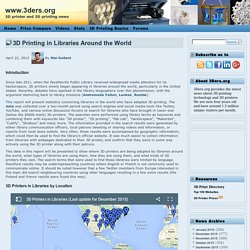
Recently, debates have sparked in the library blogosphere over this phenomenon; with the argument stemming back to library missions (Andromeda Yelton, Lankes, Rundle). Price compare 3D printers. Printable functional 'bionic' ear melds electronics and biology. Scientists at Princeton University used off-the-shelf printing tools to create a functional ear that can "hear" radio frequencies far beyond the range of normal human capability.

The researchers' primary purpose was to explore an efficient and versatile means to merge electronics with tissue. The scientists used 3D printing of cells and nanoparticles followed by cell culture to combine a small coil antenna with cartilage, creating what they term a bionic ear. "In general, there are mechanical and thermal challenges with interfacing electronic materials with biological materials," said Michael McAlpine, an assistant professor of mechanical and aerospace engineering at Princeton and the lead researcher.
"Previously, researchers have suggested some strategies to tailor the electronics so that this merger is less awkward. Masdar Buys Inkjet Printer for 3D Printing Solar Cells! The Masdar Institute of Science and Technology (MIST) in Abu Dhabi, which is affiliated with the Massachusetts Institute of Technology (MIT), has purchased a Fujifilm Dimatix DMP283 inkjet printer – the learning institute’s first step towards printing its very own solar cells!

For the longest time, the United Arab Emirates had no chance to keep pace with the western world’s clean tech advancements mostly because of a dearth of skills and a non-existent supply chain of necessary materials. But that is changing now as government and civil society leaders recognize the importance of keeping pace with western developments – particularly to secure the region’s energy hegemony for the future. As such, Beirut recently opened the first 3-D printing shop and now MIST, a branch of Masdar, has announced that it has purchased a Fujifilm Dimatix DMP283 inkjet printer in order to prepare its graduate students to learn how to print their own organic optoelectronics. “Dr. MIST President Dr. :: Arab Brains. 3D Printing Technology Poised for New Industrial Revolution. When the TV series Star Trek first brought the starship Enterprise into German living rooms, the concept of a replicator was pure science fiction, a fantastical utopian vision we might experience one day centuries in the future.
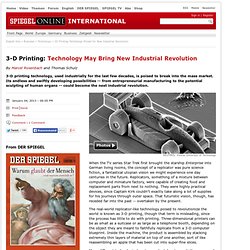
Replicators, something of a mixture between computer and miniature factory, were capable of creating food and replacement parts from next to nothing. They were highly practical devices, since Captain Kirk couldn't exactly take along a lot of supplies for his journeys through outer space. That futuristic vision, though, has receded far into the past -- overtaken by the present. The real-world replicator-like technology poised to revolutionize the world is known as 3-D printing, though that term is misleading, since the process has little to do with printing. 3D Printing Moving Parts Fully Assembled - 28-Geared Cube. Got a Kinect and a laptop? Get ready to 3D print. Volumental's vision is to be able to 3D print more or less anything you can see Image Gallery (7 images)

'Solar Sinter' by Markus Kayser is a solar powered 3D printer that uses sand as source material #3dprinting #environment #energy #rca. Amongst the wonderful collection of work currently on show at the Royal College of Art, in the corner on the first floor sits an installation/object by Markus Kayser called Solar Sinter.
An MA Design Products student project, Solar Sinter is probably one of the most inspiring projects this year, aiming to raise questions about the future of manufacturing and triggers dreams of the full utilisation of the production potential of the world’s most efficient energy resource - the sun. In a world increasingly concerned with questions of energy production and raw material shortages, this project explores the potential of desert manufacturing, where energy and material occur in abundance. Porównanie elektroniki do reprapa. Po trzech tutorialach opisujących budowę drukarki Mendel Prusa, przyjrzymy się teraz kilku sprawom dotyczącym elektroniki, bez której nie może się obejść żadna drukarka.
Typów układów jest wiele, i nie znając się za bardzo na temacie na pewno trudno wybrać model pasujący do naszych potrzeb. Aby uprościć ten wybór, skupimy się tutaj na trzech modelach : Generacja 3, Sanguinololu i RAMPS. Free 3D Models, Free CAD Models. Solar Sinter Project: 3D Printing with Sunlight and Sand. I’m absolutely amazed by Markus Kayser’s Solar Sinter Project, a 3D printer that uses the sun for power and sand as its raw material: In a world increasingly concerned with questions of energy production and raw material shortages, this project explores the potential of desert manufacturing, where energy and material occur in abundance. In this experiment sunlight and sand are used as raw energy and material to produce glass objects using a 3D printing process, that combines natural energy and material with high-tech production technology.Solar-sintering aims to raise questions about the future of manufacturing and trigger dreams of the full utilisation of the production potential of the world’s most efficient energy resource – the sun.
Build a Laser 3D Printer - Stereolithography at Home. Here is how to make a Stereolithography 3D Printer. It is still a bit of a work in progress but so far it is working pretty well. This is mainly an experiment which started as a Delta Robot Stereolithography Printer but ended as a more traditional Cartesian Stereolithography Printer. "I'll be honest, we're throwing science at the walls here to see what sticks.
3-D printing: Wave of the future. 3-D printing: Wave of the future If you’ve been wondering about 3-D printing, it’s probably for the same reason we are. On May 17, we learned that surgeons had placed a life-saving support — built on a 3-D printer — into the airway of Kaiba Gionfriddo. Credit: The Why Files. 3D Printing - A ubiquitous technology. DIY Stereolithography 3D Printer. Prusa. Bonjour, En suivant les différents articles que j’ai publié jusqu’à maintenant, vous devriez arriver à un résultat semblable à celui-ci, voir mieux si vous êtes plus ordonné que moi.
Afin de poursuivre notre avancée vers le fonctionnement final de la Prusa, nous allons voir comment monter, positionner et enfin paramétrer les fins de course (switchs). Tout d’abord, il faut savoir que les capteur de fin de course ont 2 fonctions au sein de la Reprap ( et des autres imprimantes). Prévenir le shield RAMPS que le chariot de l’extrudeur a atteint l’une des extrémités des axes et qu’il faut stopper le moteur sous peine de casser le matériel. Pour cela 6 capteurs ( 2 par axes) sont nécessaires. A savoir: le fonctionnement de ces 2 types de capteurs est inversé, l’extrudeur est arrivé en fin de course lorsque qu’un capteur mécanique est en position fermé (languette rabattue) ou lorsqu’un capteur optique st en position ouverte ( faisceau coupé). 3-D Printer Brings Dexterity To Children With No Fingers : Shots - Health News. Hide caption One version of the Robohand includes 3-D printed parts assembled with metal hardware. New parts can be easily "printed" as the child grows.
3Doodler: The World's First 3D Printing Pen by WobbleWorks LLC. 3D Ink™ brand plastic filament. MIT Researchers are Printing Solar Cells on Sheets of Paper Published on August 20, 2011 by admin · No Comments Geek.com. Category: 3D Printing. View More Square plate Leapfrog Creatr (To stiffen the frame) by Ghost3D 18 mins ago. Stereolithography: The Science behind 3D Printing.
RoBo 3D Printer by RoBo 3D Printer. 1) Unassembled Kit w/ ABS- $475+$99+shipping (locally or internationally) 2) If you already pledged for a kit and want to do a $99 ABS upgrade, just go to manage your pledge and add an additional $99 and we will be able to process it on our end. Two Makers Come Together To Make A Robotic Hand For A Boy In South Africa. Two makers on opposite ends of the globe, Ivan Owen in Bellingham, Washington and Richard Van As in South Africa, teamed up to build a custom robotic hand and publish it on Thingiverse. The best part? Flexible Solar Cells Mounted On Everyday 8.5 x 11 Paper. By: David Russell Schilling | June 18th, 2013 Miles Barr, an MIT student studying chemical engineering, was awarded the 2012 $30,000 Lemelson-MIT student prize for his innovative “Printed Paper Photovoltaics” or “3PV” design.
The design competition was funded by Italian oil company Eni which invested $5 million in the Emi-MIT Solar Frontiers Research Center at MIT. The center also received $2 million from the National Science Foundation (NSF). How to Make Everything Ourselves: Open Modular Hardware. This Mind-Controlled 3-D Printer Generates Creatures From Your Kid's Brainwaves.
World's First 3D-Printed Architecture by Smith. Amaze project aims to take 3D printing 'into metal age' NASA develops 3D printing factory in space. 3D Printing Month. Why Does 3D Printing Matter? LEGObot 3D Printer. Cubify - Express Yourself in 3D. Express Yourself in 3D. 3D-Coat - Voxel sculpting, Retopology, UV-mapping, Texture painting. 3-D Printing Will Change the World. The audacious plan to end hunger with 3-D printed food - Quartz. The Most Incredible 3-D Printed Things We’ve Ever Seen ⚙ Co.